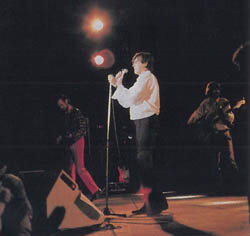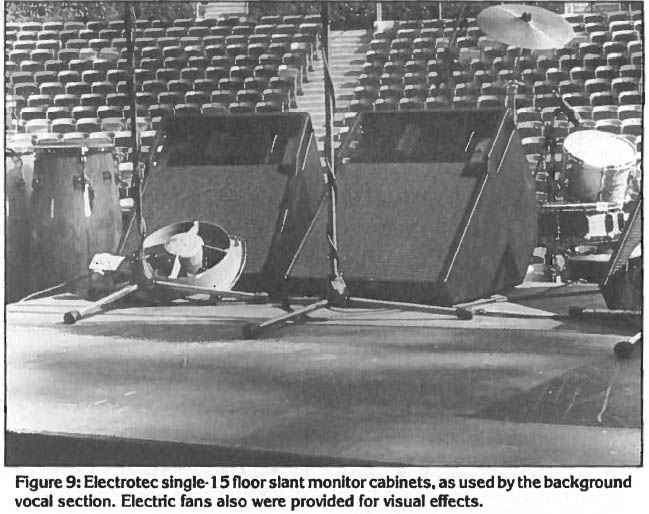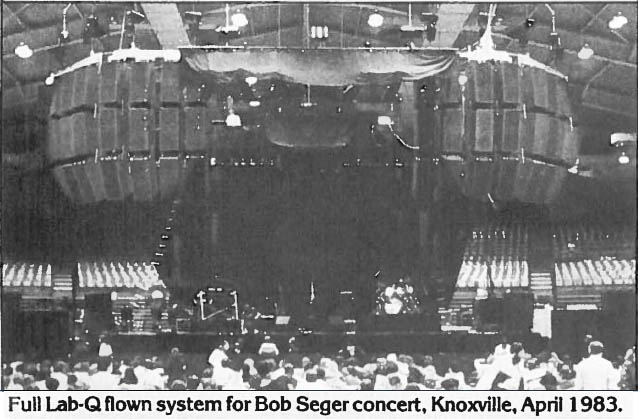
Monitor System
Stage monitors were handled by Electrotec engineer Bill Chrysler. The Electrotec Soundcraft 32-channel board was driving 13 separate stage monitor speakers, arranged on 10 mixes.
“I’m using the 10 mixes for Roxy Music, so that still leaves me with six discrete outputs for opening acts,” Chrysler offers. “After Roxy’s sound check, I go around to the back of the board and change my output patching; that way the levels I’ve set for Roxy don’t get touched until they come on stage again. Six more mixes is usually more than adequate for most opening acts.”
Chrysler’s 10 monitor mixes for the headline band were set up as follows: sidefills; keyboardist; bass guitarist; lead guitarist; Ferry’s downstage vocal mix; drummer; background vocal; sax; stage-left guitarist; and percussionist. During sound check he was able to speak directly to each stage monitor mix area via the console’s built-in talkback facility.
Monitor speakers were of three types. Sidefills comprised a Lab-Q stack on each side. The keyboard mix was heard through a three-way composite box measuring approximately 3 by 4 feet.
All remaining mixes were driven through an Electrotec single-I5 floor slant, which contains a single 15-inch JBL E130 speaker and a 2441 driver on a 2390 horn/lens attachment (Figure 9). The wooden box has a cutout around the lens that serves as protection for the fragile metal lens plates, while offering unobstructed lateral dispersion at the same time; it also serves as a carrying handle.
Monitor Electronics
Electrotcc’s monitor system features Klark-Teknik DN27 third-octave graphic equalizers, into which have been built the crossover units. Using the DN27’s power supply, each custom-designed card offers bi-amp mix capability with a crossover point of 1.5 kHz. High and low output adjustments are located on the equalizer’s front panel. The system Chrysler was tending for Roxy Music offered these third-octave EQ/crossover units on 12 of the board’s available 16 mixes.
Graphics and other monitor processing gear were contained in three electronics racks, which he stacked on top of his monitor amp racks for quick access (Figure 10). The racks included eight sides of Omnicraft GT-4 noise gates for drum use; according to Chrysler, however, they had not been necessary yet with this show.
One of the system’s more sensible features was a spare power supply for the monitor console located in the same road case as the primary supply, pre-wired and switchable on-line should the need arise. Referring to the monitor system at his disposal. Chrysler says that usually he will adjust the graphic equalizers during Roxy Music’s sound check, and then leave them set.
“I don’t get into changing things just for an opening act—that can jeopardize Roxy’s set,” he continues. “If a mix does not sound right for the opening act with that EQ in-line. I can easily switch it out. Our wedges (monitors) are really quite flat, so that works fine. I can make both acts happy with very little dial-twisting.”
The Electrotec slant monitor is claimed to have a frequency response of 70 Hz to 18 kHz, ±3 dB. A sound pressure level of 125 dB at the listener’s ears is said to be possible with this system. Chrysler’s Electrotec/Soundcraft monitor console offered great flexibility in the EQ department, he says, with its four-band parametric capabilities on each output mix, also switchable in and out of the line.
Output mix levels are displayed on an LED ladder-type visual readout. “I will rarely, if ever, go into the red zone,” he relates. “With the (JBL) 6233 amplifiers, and the crossover line-drivers in the EQ units, I have tons of headroom. The system sort of idles through the show, which is really good; no distortion.”
With the Lab-Q stacks on stage for sidefill speakers, onstage monitor levels were quite high during sound check, yet the console’s LRD displays were consistently percolating 4 to 6 dB below clipping.
Showtime—The Acid Test
Roxy Music presents a musical show that covers a great dynamic range, with the included program material ranging from soft instrumental ballads with alto sax lines, to double-guitar-riffing, sledgehammer rockers. The Electrotec sound system was called upon to respond instantly to level changes of 25 dB or so, and appeared to be remarkably quiet—no “hiss” was present during the softer numbers.
As the show progressed, the louder numbers became almost welcome. The Lab-Q low-end section was capable of punching a lot of air in the 40 to 100 Hz region, which had positive effects on the crowd’s response. One young woman 200 feet or so from the speaker stacks asked me why she could feel.the music’s low notes “in her chest” … I found it best not to try to answer that one.
The San Diego State University outdoor amphitheater is a venue that usually dispels the show’s low-frequency program material by the time sound reaches the upper regions of the seating area, but the Lab-Q system changed that. The upper half of the amphitheater seating area actually seemed to have a greater bass response than the closer-in front seating rows; a reflection, perhaps, on the three-high stacking of the low-end cabinets, which created strong bass line arrays.
And the high frequencies carried well too—vocal sibilance and intelligibility was excellent, even in the highest seating rows. As stacked in that venue, the Lab-Q speaker system arrays did indeed have a high “Q” (directivity factor). As I walked the upper perimeter from left to right, it was possible to tell when I was directly on-axis with the center of each stack of three cabinets.
However, the transitions were smooth, and an untrained ear would not have noticed the hot spots. All told, an excellent outdoor speaker system that would almost certainly perform just as well in arena situations.
The Electrotec Lab-Q system also was servicing Bob Seger, Alabama, Rick Springfield, John Cougar, and Tom Petty as this article is being written. Concert sound engineers would find a visit to one of these shows well worth a listen, since, to this writer at least, the new Lab-Q speaker system represents a qualitative improvement over the company’s older component sound system.
Editor’s Note: This is a series of articles from Recording Engineer/Producer (RE/P) magazine, which began publishing in 1970 under the direction of publisher/editor Martin Gallay. After a great run, RE/P ceased publishing in the early 1990s, yet its content is still much revered in the professional audio community. RE/P also published the first issues of Live Sound International magazine as a quarterly supplement, beginning in the late 1980s, and LSI grew to a monthly publication that continues to thrive to this day. Our sincere thanks to Mark Gander of JBL Professional for his considerable support on this archive project.
Read more RE/P Files here.



